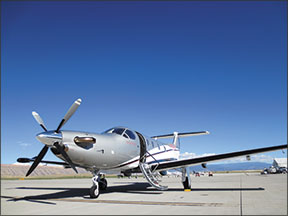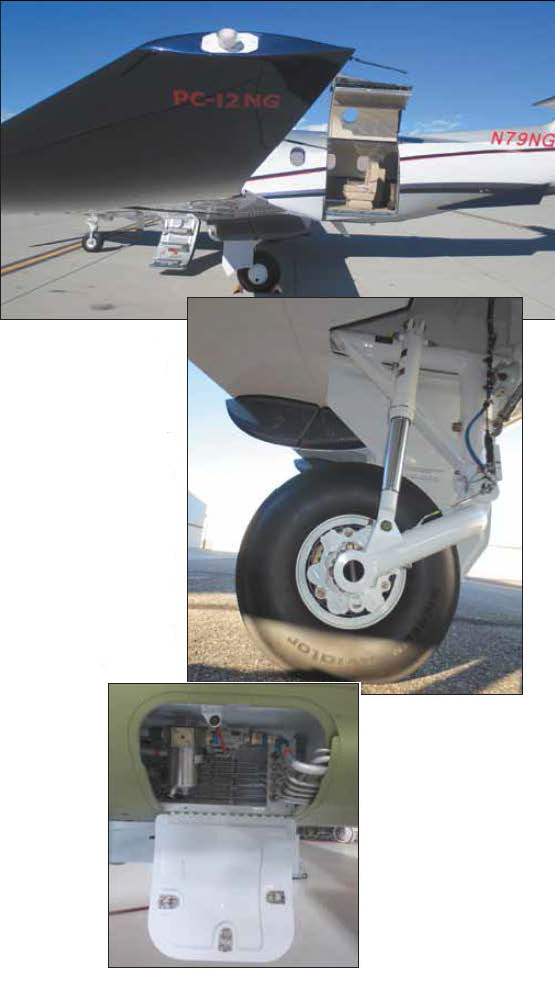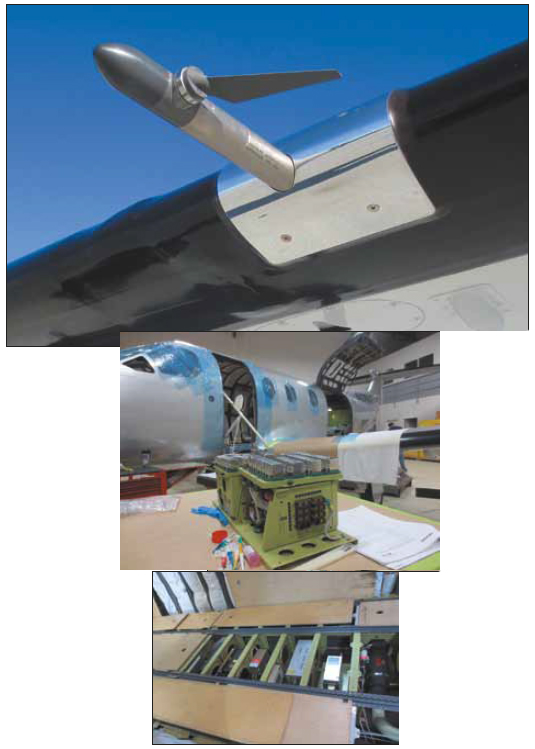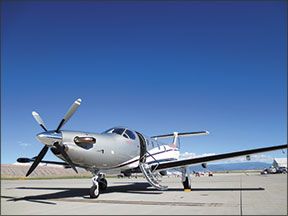Don’t let the advertisers lie to you—every design involves compromises. Attempting to optimize any one aspect of a vehicle means accepting less-than-optimal outcomes for other aspects. Ever since the Wrights, trying to come up with an airplane that does everything we’ll has driven more than a few aeronautical engineers around the bend or into other occupations.

That being said, there are a few airplanes that are true utility infielders—seemingly able to do anything needed by their operators. The Pilatus PC-12 is one of them. Back in 2007, when we first reviewed it, we were impressed by its wide spectrum of capabilities—and we think the upgrades, primarily power and the impressively capable Honeywell Apex flight deck, that led to the Next Generation (NG) designation (don’tcha just love marketing types facing creative block?) have made the aircraft even more able.
Sure there are compromises—it’s a capable back-country airplane but not a STOL design. It’s not as fast as some turboprops, but it carries a lot more than they do and there are more fuel-efficient turboprops, but they don’t have the cabin size.
Delivering 1200 PC-12s in 19 years to every sort of private, governmental and military user that can be imagined seems to indicate that Pilatus made the right design choices, in a user-friendly manner.
Load It Up
The PC-12 NG we flew had a basic empty weight (which includes the pilot) of 6528 pounds. With 2704 pounds of fuel in the wings—the full 402 gallons usable—it was possible to put 1218 pounds of payload in the cabin. That’s six 200-pound passengers in the top-of-the-line BMW-designed seats, in addition to the pilot, and a community toilet kit.
Full fuel gives an NBAA IFR range with a 100 NM alternate airport of 1200 NM—VFR range is in excess of 1800 NM. Filling the bigger-than-a-King Air 250 cabin with people and stuff to the max zero fuel weight of 9039 pounds allows carrying 1400 pounds of fuel, more than half tanks. Max landing weight is 9921 pounds, meaning that after a max weight departure, 529 pounds of fuel, or just under 77 gallons, have to be burned off—a bit more than an hour’s flying time.
Our weight and balance calculations indicated it would take some creative loading to get the PC-12 NG out of CG. Of course there’s an app for weight and balance that allows the calculation to be run in a matter of seconds.
The cabin layout is sensible. The 53-by-52 inch cargo door is positioned aft of the wing trailing edge. As the airplane is targeted at a number of markets, including owner-pilots, air ambulance, corporate, military, law enforcement and surveillance, there was a desire to make certain that the pilot did not have to walk through the cabin when securing the airplane for departure.
Once everyone and everything is in the cabin, the cargo door is closed from outside by simply depressing and holding a button on the aft fuselage (letting go of the button stops the door, reducing the risk of an ouch). The pilot then boards via the airstair forward, closes it and turns left into the cockpit without disturbing what’s going on in the cabin.
In the executive configuration, there is a lavatory opposite the airstair. Doors, immediately forward and aft of the lav, close completely across the cabin, making it private.
Cabin
As a comparison, the cabin is slightly larger than a King Air 250. At $4.6 million, the PC-12 NG is less expensive than the King Air, and at 260-280 knots, doesn’t go quite as fast, but the King Air will only carry 165 pounds in the cabin with full fuel. We were told that a number of PC-12 owners who moved up to jets came back to the PC-12 because getting a similar cabin size and load hauling ability meant spending three times the money.
Some 70 percent of PC-12s are originally sold into the Western Hemisphere. Those are built in the Pilatus facility in Switzerland, then ferried, sans interior, to Rocky Mountain Metro Airport, in Broomfield, Colorado, where the interior is installed and other finishing touches accomplished.
Mission Flexibility
Because of the airplane’s ability to loiter—pulling the power back to a cruise speed of 115 knots gives nearly 12 hours of endurance—the PC-12 NG is proving popular in a surveillance role. Using a sophisticated sphere of electronic observation equipment that can be electrically lowered from the hell hole aft of the cabin, a PC-12 can stand off as far as 10 to 15 miles and track a person in a vehicle or on foot.

The airplane is as effective as a helicopter, without leaving the huge noise footprint, and often less expensive. Over the last 10 years, law enforcement and military purchasers have edged out sales to private owners. Big Brother really is watching and he’s increasingly using a PC-12 NG.
Systems
Systems of the PC-12 NG are either simple or automatic and clearly designed to keep the pilot’s workload low. The flight controls are a combination of push-rod and cables. The fuel system is housed in two tanks, one in each wing and is simply “on” or “off.” The system automatically balances the fuel between the tanks and annunciates if it fails. The trailing beam landing gear is held up hydraulically, so it can free fall in the event of a failure. The two-buss electrical system is powered by two 300-amp generators—one is a starter-generator. Load shedding is automatic in the event of equipment failures.
Crashworthiness
The PC-12 NG is we’ll designed from a crashworthiness perspective. Although there is fuel forward of the wing spars, it is protected by a robust leading edge. Our review of accidents showed some wing damage events, but none led to fires. The only post-crash fires involved high-speed impacts from flight. Fuel lines are routed outside the pressure vessel.
Even though a control yoke is used rather than a side stick, it does not project from the panel, waiting to impale a pilot. We were surprised to see an out-of-date design four-point crew and three-point passenger restraints. The seat belt and shoulder harnesses are separate rather than being integrated. Because users are likely to use only the seat belt rather than both the seat belt and shoulder harness, the aviation and auto industries went to integrated harnesses decades ago to reduce the number of traumatic head and serious lower back injuries during impact.
We like that there are three, rather than two, cabin exits, two doors and the over-wing emergency exit.
Preflight
The walk-around inspection reveals some other design features we like. Access panels on the lower portion of the nose open downwards and the interior space is painted white so anything leaking or dripping should be immediately apparent. There is a sight gauge to use for checking engine oil quantity—no need to open up the system via dipstick, so no danger of leaving it off. The oil filler has a float valve to prevent oil loss should the cap be left off.
The long-span flaps extend under the fuselage and move on articulating arms milled from aluminum billets and bearings rather than on tracks. The small ailerons have servo tabs that lighten the control forces. Pilatus went through three iterations of aileron, servo tab and winglet design before being satisfied with forces and overall harmony.
Due to the lack of availability of TKS fluid at many places around the world, deice boots are used. They are milled into the leading edges—there is no step or discontinuity between the boot and wing.
Aft fuselage strakes add yaw stability and make the PC-12 NG the only airplane we know of that has no restriction to its flight envelope if the yaw damper is inop.
Entry to the pilot’s seat is not difficult, despite the need to maneuver past a control pedestal that extends between the front seats. The pilot’s seat has more head and legroom than we are used to in aircraft of this size, something we expect is greatly appreciated in an airplane that can have an endurance of up to 12 hours.
Departure
Startup is a matter of pushing the start button, introducing fuel as the engine spins up and monitoring to avoid a temperature overshoot. With the flight plan in the Apex system (see sidebar), preparation for departure is stunningly simple: Trims are set, 15 degrees of flap selected and the stick pusher and shaker tested—that’s it.
Lined up, it’s simply a matter of pushing the power lever to the stop—no need to stop at an intermediate position and fiddle to set torque—it’s automatic. We applaud this simplicity, as blasting down the runway behind a power loading of 8.7 pounds per horsepower is no place for a pilot to be head down. At gross weight, on a standard day, the PC-12 NG requires only 2650 feet to launch and clear a 50-foot obstacle.
Raising the nosewheel at 80 knots is a matter of applying moderate back pressure—no yanking and releasing as is the case with some T-tail airplanes. The airplane rapidly accelerates to a cruise climb of 140 knots and ascends at just under 2000 FPM. Once the yaw damper is engaged, it takes care of rudder trim, so there is little to do with one’s feet despite what would otherwise be major rudder inputs with speed and power changes on a 1200-HP single.
With new, higher thermodynamic limits for the PT6A-67P engine as part of the NG upgrades, there’s more real-world power available for cruise, boosting max cruise speed to 280 knots from 270 knots. It’s reflected in a slightly higher fuel burn, although range is minimally affected.

The noticeable effect is a more prompt arrival in the flight levels because the full 1200 SHP can be maintained to a much higher altitude. Maximum operating altitude is 30,000 feet, although going above FL270 is rarely worthwhile from a fuel burn perspective unless the tailwinds are truly whistling.
During two runs to compare book speeds to real life in the flight levels, we observed that they were comparable—at FL240 the book called for 263 knots on 403 PPH and we saw 265 knots on 410 PPH, although we were nearly 1000 pounds below gross. All in all, planning for a 260-knot cruise on 65 GPH should prove appropriately conservative. And, frankly, what else will haul that much, that size cabin, that high, that fast while burning less than 70 GPH?
Single Engine
Of course, the counter is to point out the lack of engine redundancy. The single versus twin argument raging since Lindbergh flew the Atlantic will never be resolved. The ultimate decision as to buying a single versus a twin turboprop is up to those who write the checks, and it’s not always rational. Nevertheless, with an engine shutdown/failure rate for PT-6s of better than one in 300,000 flight hours (how much depends on the source), a 16-to-1 glide ratio, a nearly 2000 FPM rate of climb and the ability to glide some 77 NM to sea level from a shutdown at FL300, engine failure accidents are not anywhere near the top of the risk list for the PC-12 series.
The integrated nature of the Apex flight deck means that should something go wrong, most of the time it is handled automatically. An annunciator tells the pilot what is going on and there’s plenty of time to pull out the manual, flip to the appropriate tab, see what effect there will be on the continuation of the flight and follow the appropriate checklist.
The EFIS display uses a “track”-based presentation, which means that the path of the airplane is depicted rather than its attitude.
If the symbolic airplane is on the horizon, the airplane is flying level, no matter what its speed. It takes only a short time to adjust to after years of flying pitch attitude displays, and then one wonders why this isn’t standard on all glass cockpits.
In a steep turn—the PC-12 NG is nicely responsive in all axes—simply putting the track display on the horizon means holding altitude. When lined up with the runway using the synthetic vision presentation, the system will build a three-degree glideslope—and placing the track display 1000 feet past the runway threshold means that’s where the airplane is going and where you’re going to start your flare.
Maneuvering
Maneuvering the PC-12 NG in steep turns, slow flight and in a very tight traffic pattern showed another reason why this airplane is popular with a wide variety of users. It’s nimble and responsive—forces are similar to a Beech Baron or 400-series Cessna.
Due to rolloff at the stall with power—good grief, it’s got 1200 SHP up front—stalls are prohibited and the airplane has a stick shaker and pusher. We found control to be smooth and positive in all axes we’ll into the regime of the shaker, with no problem making abrupt rolls at very slow speed. The pusher doesn’t mess around, reducing angle of attack assertively.
Full flaps, 40 degrees, provides substantial drag so flying out of a stick pusher event, with full power applied smartly, still requires the sacrifice of a few hundred feet to accelerate out of the near stall speed regime and establish a climb.
Angle of Attack
Another feature we applaud in the NG airplanes is the integration of the angle of attack system into the airspeed presentation. Rather than a separate AOA indicator, information from the twin AOA sensors (one on each wing) is fed through Apex to a green Dynamic Speed Bug on the PFD.
The presentation damps AOA indications that bounce around in turbulence and shows a true 1.3 Vso speed to fly on final. The system corrects for icing conditions—once ice protection is activated, the AOA presents the appropriate speed to fly with an ice-contaminated airframe. It’s miles ahead of the current technique of “keep the flaps up, go as fast as you can on final to avoid stalling and hope you can stop before you run out of runway.”
Landings are embarrassingly easy with the trailing beam gear and effective rudder. The PC-12 NG has a range of demonstrated crosswind numbers, based on flap deflection—the highest being 30 knots. The only GA airplane we know that can handle stronger crosswinds is the Ercoupe.
Control on rollout is positive—getting down and stopped on a 3000-foot runway at sea level should not present any problem to a pilot who flies final on speed, although our review of accidents indicates that the leading cause of PC-12 landing accidents is too much speed on final.
Conclusion
We think that Pilatus has taken one of the best all-around airplanes on the market and made it several notches better. The combination of upgrading to the user-friendly and capable Honeywell Apex system, bumping up the power of an already big engine with minimal range loss, and integrating the AOA into the Dynamic Speed Bug serve to enhance safety and increase the utility of an airplane that does almost everything well.


